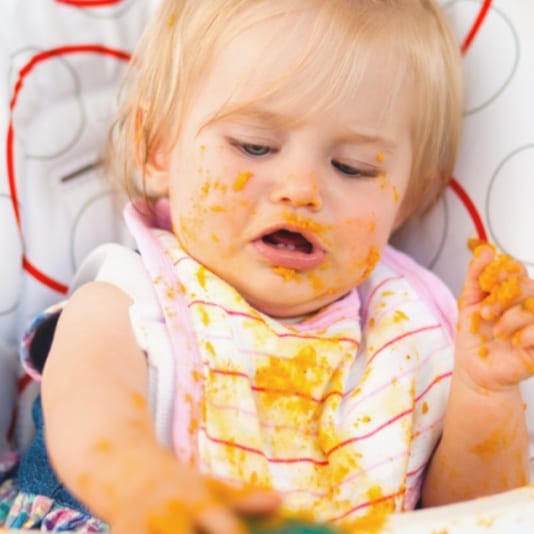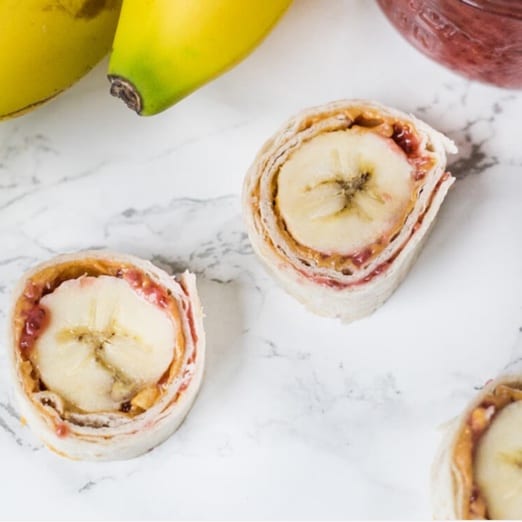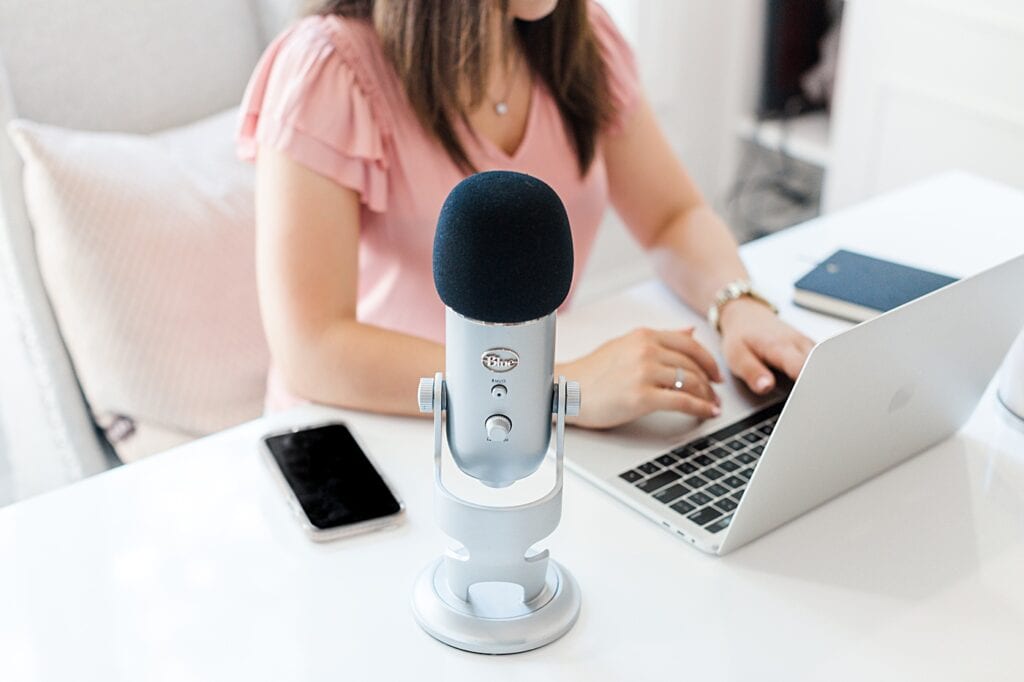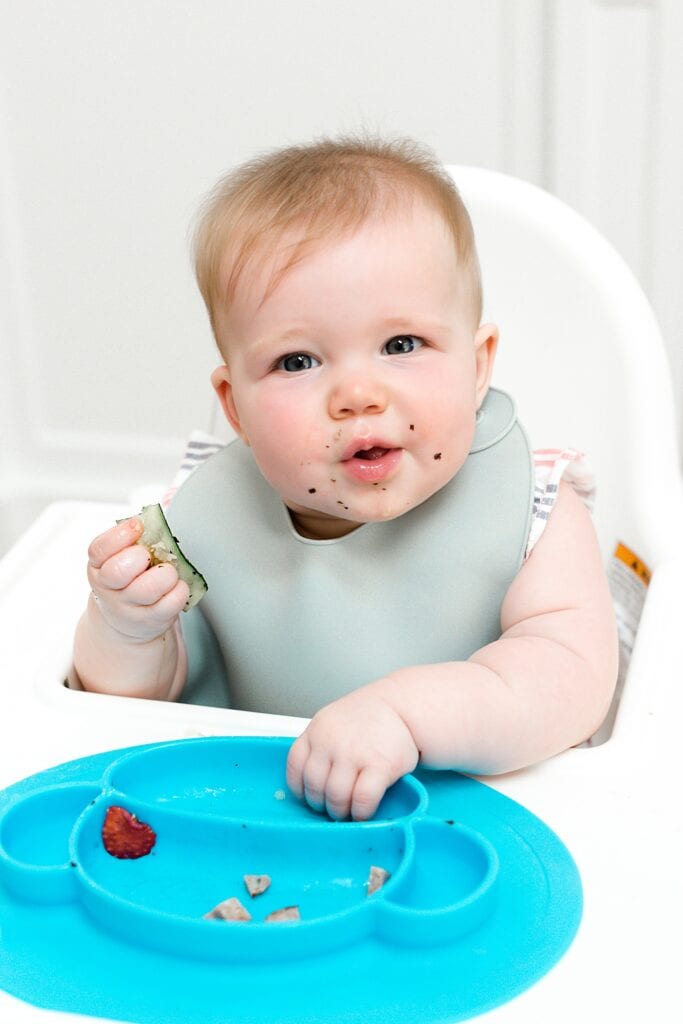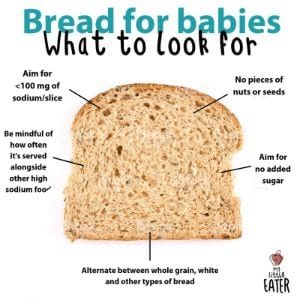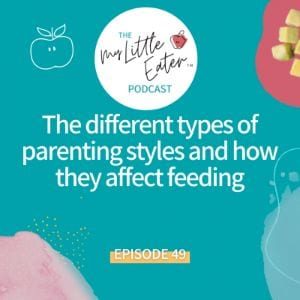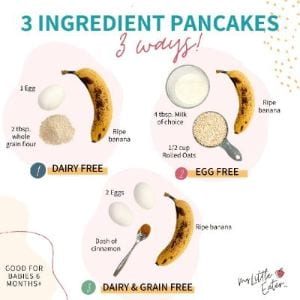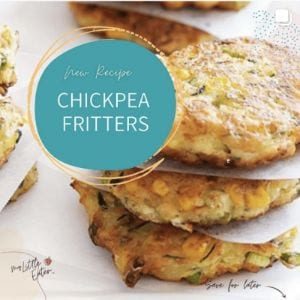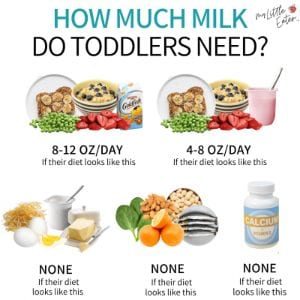
This is an important topic to cover, no doubt, and is one of the first things parents look up when just starting solids. It can also be a cause for confusion, especially as babies turn to toddlers and we start to become more unsure of whether or not something still constitutes a choking hazard.
Did you know that I wasn’t familiar with all of the choking hazards when I had my first son? I thought I was! But it was only when my son was almost two that I realized that thick peanut butter eaten off of a spoon was a choking hazard!! Maybe you didn’t know this either?
Let’s read on to get all the deets.
Choking Hazards for Babies and Toddlers under 4
The biggest thing to think about when determining if something is a choking hazard is: “Is this a texture that can easily get lodged in my baby/toddler’s airway when swallowed whole (or parts of it are broken off?).” It’s especially dangerous if it’s small and round shaped, as this can more easily block off all air in the airway if swallowed whole, and also of course, if it’s a harder texture. A baby’s airway is about the size of your pinky finger, or the size of the opening of a typical drinking straw. You can use that as a guide to determine if it needs to be modified in shape, or avoided altogether.
One thing to note right off the bat is that choking hazards are the same for all kids, regardless of whether you’re doing puree feeding or baby led weaning!
Typically speaking, we start the top of the list with those items that aren’t easily squishable, or don’t dissolve easily in the mouth with saliva.
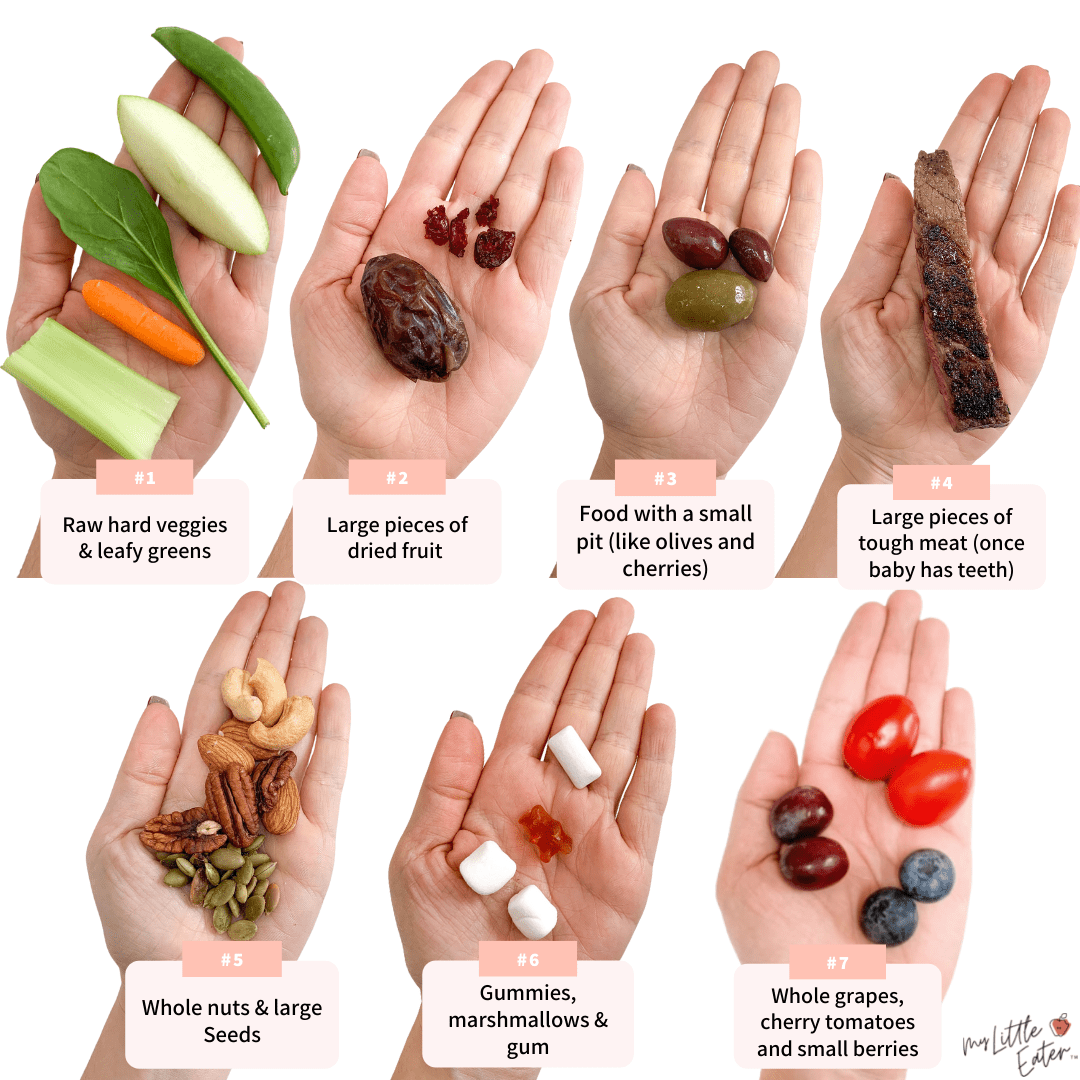
That includes the following:
- Raw hard veggies and fruit, like raw apple, raw under-ripe pear, raw carrots, raw celery, raw leafy greens (you need your back molars to be able to chew these well)
- Hard candy
- Whole cherry tomatoes
- Whole grapes
- Whole blueberries
- Anything with a small pit still in it (e.g. olives, cherries)
- Dried fruit (like raisins, dried apricots, etc.)
- Whole nuts and seeds (like sunflower and pumpkin seeds)
- Large/very tough pieces of meat like steak
Obviously (I hope), things like small bones in fish or meat are choking hazards too (even for adults!).
Next, we move onto things that are stick shaped.
Maybe your baby/toddler can chew it pretty well but serving it in a stick shape is dangerous. As again, if swallowed before it’s completely chewed, it can block the airway in its entirety. This includes things like:
- Hot dogs
- Sausages
- Cheese sticks/strings
We’re going to add to the list things that are really gummy, chewy, sticky, and are hard to swallow, especially if they get large amounts in their mouth.
This includes things like:
- Gummies
- Marshmallows
- Chewing gum
- Thick globs of peanut butter
- Soft, fresh bread (for babies <1 year) (very fresh bread can gum up in the mouth and be hard to chew through)
Finally, we’re going to end the list with foods that can crumble into really jagged pieces in the mouth and can easily get lodged in the airway, which include:
- Hard chips like nachos/potato chips/pretzels (super dry crackers should be avoided under 12 months of age)
- Popcorn
Just so it’s an easy to view list…here they are again. PS>> you can click on the image to download this and print it off for easy reference! Pop it on your fridge, offer it to caregivers, grandparents, the daycare, or anyone else who may be feeding your baby/toddler.
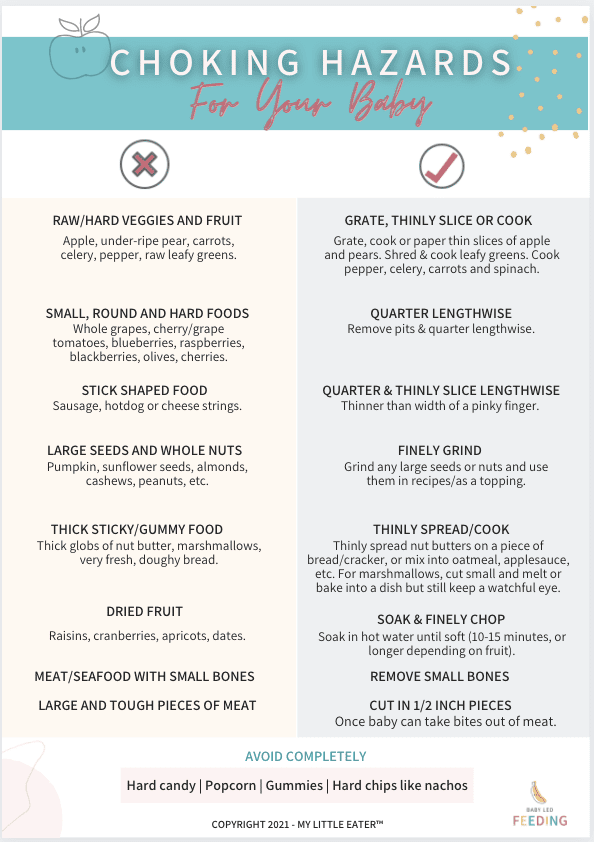
Modifications to make things safer
OK, OK…does this mean you can never give your baby or toddler things like apples, carrots, tomatoes, etc….ever??
Definitely not.
There are ways to modify certain foods to make them more safe for sure. Here’s how you can do so:
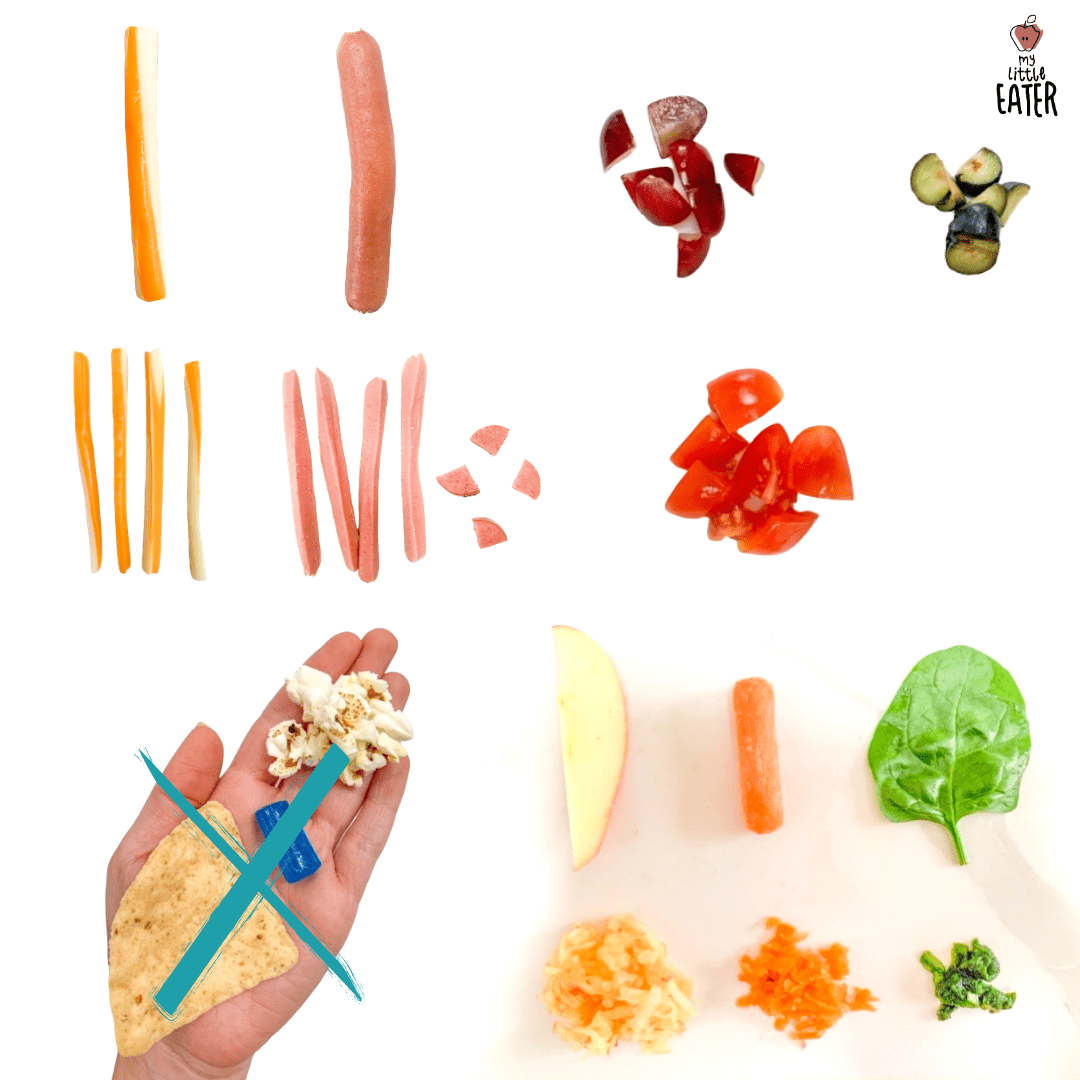
- Grate things like raw apples, carrots, and under-ripe pears. You can also very thinly slice the apples and pears so that they aren’t in a thick wedge/sliced form (that can result in small, hard chunks being easily broken off).
- Poach or steam fruits like apples and pears (can be sliced and cooked on a pan/in a microwave with water or butter to soften them up).
- Cook foods like raw peppers or raw carrots so they’re softer. You can offer raw peppers around 18 months+ depending on chewing ability.
- Thinly shred or cook leafy greens (so it’s not so hard to chew).
- Quarter small, round food like grapes, cherry tomatoes, and blueberries. You can smush them lightly between your fingers as an alternative.
- Thinly slice stick shaped food like hot dogs and cheese sticks lengthwise (thinner than the width of your pinky finger).
- Thinly spread nut butters on a piece of toast or cracker, or you can thin it out by mixing it into oatmeal, applesauce, or other puree-like textures.
- Offer marshmallows in small pieces only when melted into a dish.
- Grind nuts or large seeds, or very finely chop them, and keep a watchful eye.
- Soak dried fruit like raisins, dried apricots, dates, etc. in water for 5-10 minutes before offering them.
- Cut large or very tough pieces of meat, like steak, into 1-2” pieces.
- Lightly toast bread so that it’s not too chewy (you can stop doing this around 12-18 months + if baby is experienced with chewing this texture)
You’ll still want to 100% avoid hard candy (think lifesavers, jolly ranchers etc.), gummies, chewing gum, popcorn, and hard chips (like nachos) until 4 years of age.
But I gave my toddler apple slices or popcorn or raisins…and they were fine!
Keep in mind that all kids are different, and have different chewing and eating abilities. Some babies are more equipped than others to be able to handle things like raisins without soaking them, or can eat raw apples whole by taking calculated bites out of it, and so on. You know your child best, and you know what risk you’re willing to take. Always remember that choking can happen on any type of food. The lists above are just the foods with the highest choking risk. If you feel like you are being vigilant, and your baby/toddler is able to handle eating something…well, that’s your decision to make! But generally, to be most careful, avoiding these foods or modifying them so that they’re safer, is always going to be recommended.
Here are some precautions to take to lower the risk of choking with any food:
- Make sure your child is developmentally ready to start solids whether starting purees or baby led weaning! This doesn’t mean just interested in food. They should be sitting up straight unassisted and have good core strength to hold themselves upright when eating and strapped in their highchair. Get a full list of developmental signs of readiness here.
- Always supervise your baby or toddler when eating. Keep them facing you so you can see them eating and be quick to respond should they choke (remember…choking is silent).
- Always have your child seated when eating. Avoid letting them eat when walking around, riding in a car or playing.
- Make sure to modify all choking hazards and offer even low choking risk foods safely! My baby led feeding online course will help you with that for sure!
- Model safe eating habits and chew food thoroughly.
- Educate any caregivers who may be caring for your child about choking hazards (give them the free cheat sheet above!) and precautions to take to prevent choking. Identify emergency resources and contacts.
- Become familiar with infant and child CPR protocols.**
If you need help distinguishing between gagging and choking, check out this blog post here for more information.
Want to learn more about how to safely serve all types of foods to your baby and encourage self-feeding? I’ve got all the help you need inside my Baby Led Feeding online course!
**If you are unsure of where to access this information, please consider taking a course local to you, or the online course available through Safe Beginnings. It is one of my favourites, and one of the most comprehensive, online courses for child/infant CPR. They are truly amazing, very thorough, with video, and everything online – you’ll be prepared for if the worst happens, which is something truly worth investing in. Enroll in their course today, and use code MYLITTLEEATER for 20% off your course purchase.
Please note that the information provided above is an affiliate link.


